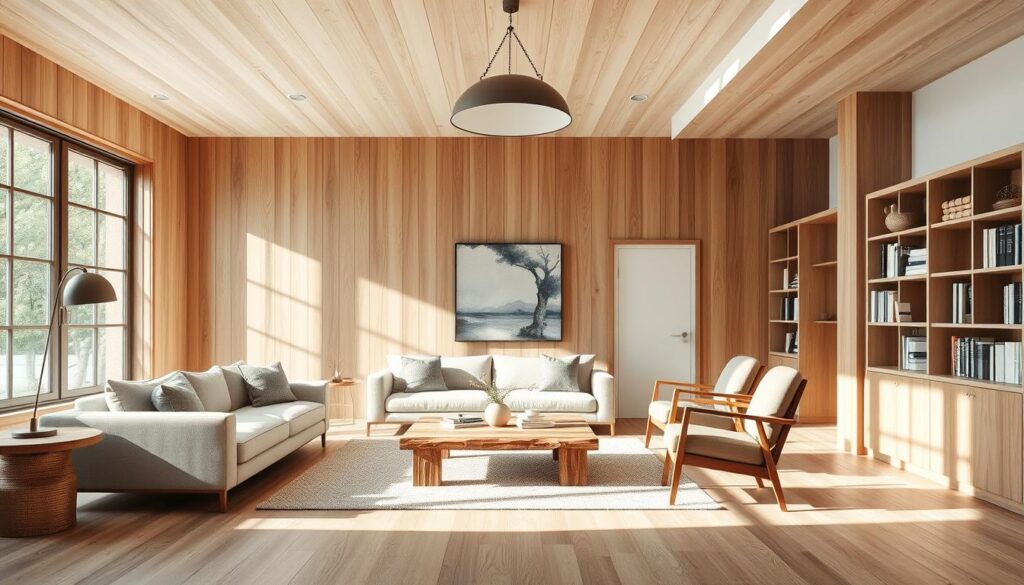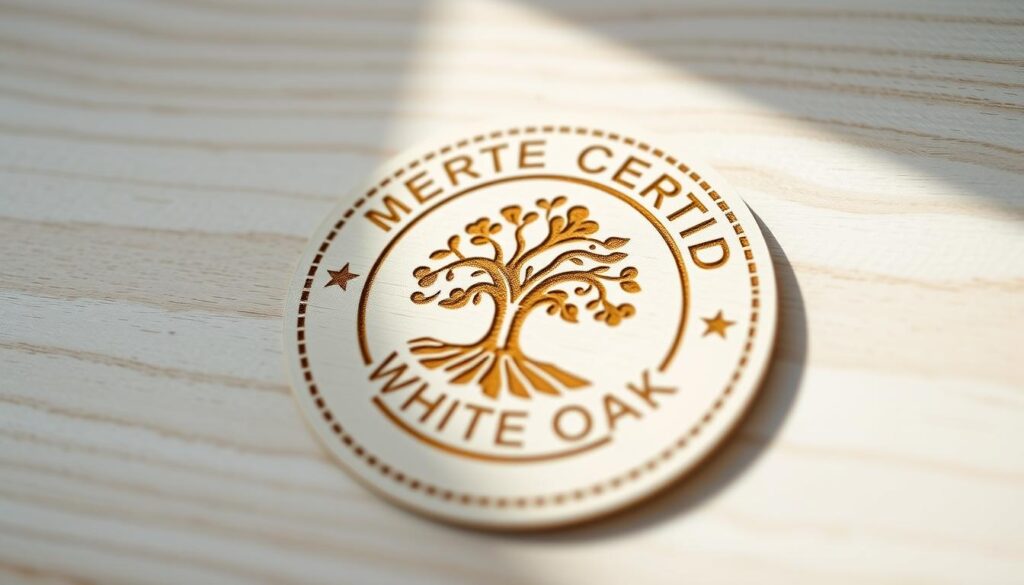Elevate your living space with the elegant and durable features of select white oak flooring. Learn why it’s a premier choice for homeowners.
Homeowners and interior designers across America are choosing select white oak flooring. It’s a premium hardwood flooring option that’s gaining popularity. Its warm, neutral tones make any space inviting and versatile.

Select grade is the highest quality in white oak flooring. It has minimal knots and a uniform look, perfect for luxury homes. This premium option offers clean grain patterns and consistent colors, making it a quality wood floor choice.
White oak flooring has stood the test of time, from traditional to modern styles. Its appeal and practical benefits make it a standout choice. Its rich history in American homes shows its timeless appeal and ongoing popularity.
Key Takeaways
- Select white oak flooring represents the highest quality grade available
- Premium hardwood flooring offers superior durability in high-traffic areas
- White oak provides a neutral foundation that works with any design style
- Quality wood floors from white oak can last for generations with proper care
- Select grade features minimal knots and consistent coloration
- White oak flooring maintains its value better than many alternative options
What Makes Select White Oak Flooring a Premium Choice
Oak flooring quality changes a lot based on its grade. Select grade lumber is the top choice for homes. Knowing about these grades helps you make smart choices for your floors.
The Grading System Explained
The National Hardwood Lumber Association made a grading system for white oak. It looks at clear face percentage, color, and natural features. Grades go from Select to #2 Common, each with its own look and price.
Characteristics of “Select” Grade White Oak
Select grade white oak looks the most refined. It has few knots, even color, and tight grain. The sapwood and heartwood look alike, giving a clean, elegant look. These floors are usually 4-10 feet long, making them stable and beautiful.
How Select Differs from Other Grades
Character grade and select grade are different. Character grade likes natural marks and color changes. But select grade wants everything to be even and perfect. Select grade has at least 83% clear wood, more than character grade. This makes select grade great for fancy rooms and designs that need to be perfect.
The Timeless Aesthetic Appeal of White Oak
White oak flooring is known for its unique natural wood grain. It has long, straight lines and subtle swirls. This combination of warmth and elegance makes it a timeless choice.
Video source from Youtube
The color of white oak ranges from light beige to medium brown. It often has gentle olive undertones that add depth. These neutral tones work well with many design styles, from rustic to modern.
Designers love white oak for its ability to adapt to different styles. Its grain texture adds interest in simple spaces but also pairs well with bold decor. This makes it a top choice for those who value lasting beauty.
“White oak floors are the equivalent of the perfect white shirt in fashion – timeless, versatile, and always in style regardless of changing trends.”
White oak boards have natural color variations that create a sense of movement. This adds warmth to modern homes and elegance to traditional ones. Unlike red oak, white oak’s colors are more neutral, making it easy to match with various color schemes.
Exceptional Durability: Why Select White Oak Stands the Test of Time
Select white oak flooring is a top choice for those looking for lasting quality. It’s incredibly strong, perfect for homes with kids, pets, or lots of foot traffic. Its natural strength protects it from daily wear and keeps it looking great for years.
Janka Hardness Rating Explained
The Janka rating oak test shows how well wood can handle denting and wear. White oak scores 1360, beating many other domestic woods. This means it can handle furniture marks, pet scratches, and more without showing wear like softer woods do.
Resistance to Wear and Tear
White oak’s tight grain and dense structure make it durable. It resists moisture, preventing warping and swelling. Its tyloses block water damage, making it last longer than other woods.
Performance in High-Traffic Areas
White oak is great for areas that get a lot of use. It’s perfect for entryways, kitchens, and commercial spaces. It keeps its look even after years of heavy use. Homeowners often see little wear after decades, making it a smart investment.
| Wood Type | Janka Rating | Moisture Resistance | Suitability for High Traffic |
|---|---|---|---|
| White Oak | 1360 | Excellent | Exceptional |
| Red Oak | 1290 | Good | Very Good |
| Pine | 870 | Poor | Not Recommended |
| Maple | 1450 | Moderate | Excellent |
Design Versatility and Compatibility with Various Décor Styles
White oak flooring is a standout in interior design for its amazing flexibility. This versatile wood flooring fits perfectly in homes across America. It works well with almost any style homeowners might choose.

Traditional Home Designs
Traditional oak flooring adds warmth and charm to classic homes. It looks great in Colonial, Craftsman, or Victorian styles. The natural grain of white oak pairs well with crown molding and wainscoting.
When paired with antique furniture and rich fabrics, it creates a welcoming, timeless feel. This celebrates the beauty of old buildings.
Modern and Contemporary Spaces
Oak floors in modern homes offer a perfect mix of warmth and simplicity. Light-colored white oak with a matte finish works well with modern designs. It adds texture without overpowering sleek furniture and simple colors.
Designers often use wide planks to make rooms feel bigger. This is especially true in urban condos and minimalist homes.
Transitional Interior Design Applications
White oak interior design shines in spaces that mix old and new. It’s a middle ground that lets homeowners blend different styles. White oak’s neutral color ties together classic details and modern pieces.
| Design Style | Recommended Oak Finish | Ideal Plank Width | Complementary Elements |
|---|---|---|---|
| Traditional | Medium to dark stains | 3-5 inches | Antique furniture, warm wall colors |
| Modern | Natural or whitewashed | 5-7+ inches | Clean-lined furniture, neutral palette |
| Transitional | Mid-tone natural | 4-6 inches | Mixed furniture eras, textural elements |
Select White Oak Flooring: Comparing Options and Investment Value
Choosing the right white oak flooring adds beauty and value to your home. Knowing the options and their value helps you make smart choices. These choices can boost your property’s worth.
Solid vs. Engineered White Oak Options
Solid oak flooring is made from a single piece of oak timber. It can last for generations and be refinished many times. On the other hand, engineered white oak has a real wood veneer over plywood. It’s more stable in changing humidity.
Return on Investment Statistics
The return on investment for hardwood floors is high today. Studies show oak floors can return 70-80% of their cost when selling a home. This makes oak flooring a top choice for adding value.
Buyer Preferences in the Real Estate Market
Real estate experts say homes with hardwood floors sell quicker and for more money. A survey found 54% of buyers are willing to pay more for homes with white oak floors. This makes it a smart choice for sellers.
Long-term Value Considerations
Hardwood floors, especially white oak, offer long-term value. They can last over 100 years and stay beautiful. White oak’s natural color doesn’t fade much, keeping its appeal over time. With proper care, maintenance costs are low, adding to its lasting value.
Sustainability Factors and Environmental Benefits
White oak is a top choice for sustainable hardwood flooring. It’s harvested in a way that doesn’t harm the forests. This makes white oak a green choice for those who care about the environment.

White oak has eco-friendly flooring credentials. Look for the Forest Stewardship Council (FSC) label. It ensures the wood comes from well-managed forests. This label means the wood was made with care for the environment.
White oak is good for your home too. It doesn’t release harmful chemicals into the air. Plus, it needs fewer resources to make than other types of flooring.
- Biodegradable at end of life cycle
- Lower carbon footprint than synthetic alternatives
- Naturally renewable resource when properly harvested
- Zero toxic emissions in your home
Choosing white oak helps the environment in many ways. It lasts for many years, unlike some other floors. This means you won’t need to replace it as often, saving resources.
| Sustainability Factor | White Oak | Vinyl Flooring | Carpet |
|---|---|---|---|
| Renewable Resource | Yes | No | Some options |
| Biodegradable | Yes | No | Rarely |
| VOC Emissions | Minimal/None | Moderate to High | Moderate |
| Average Lifespan | 50-100+ years | 10-20 years | 5-15 years |
Installation and Maintenance: Maximizing Your White Oak Investment
Getting your white oak floors installed right is key to their lasting beauty. You can choose to hire pros or do it yourself, depending on your skills and tools. Professionals can avoid costly errors, but DIY can save money if you know woodworking.
Professional vs. DIY Installation
Before you start, make sure your subfloor is clean, dry, and even. If it’s concrete, you’ll need to add a moisture barrier. Wood subfloors should be securely attached without any squeaks or movement.
Acclimation Process Importance
Let your flooring acclimate for 5-7 days in your home to avoid warping and gaps. Keep planks flat in opened boxes in the installation area to keep moisture levels consistent.
Daily Cleaning Practices
Start with gentle daily care for your hardwood floors:
- Sweep or vacuum with soft-bristle attachments
- Wipe spills immediately with a dry cloth
- Use oak floor cleaning products specifically made for hardwood
- Avoid wet mops and steam cleaners
Seasonal Maintenance Routines
Seasonal care keeps your floors looking great. Keep humidity between 35-55% all year with humidifiers in winter and dehumidifiers in summer. Clean deep quarterly with products approved by the manufacturer.
Dealing with Scratches and Damages
Minor scratches can be fixed with touch-up markers that match your floor’s color. For deep gouges, you might need a pro to refinish your floors. Refinish every 7-10 years to keep your floors looking new and protect your investment.
Cost Analysis and Conclusion: Making the Right Decision for Your Home
Thinking about white oak flooring? The cost is a big factor. Solid and engineered select white oak costs between $6 and $12 per square foot. You’ll also need to pay for underlayment, trim, installation, and finishing.
Even though it’s pricey, white oak is durable and looks great forever. It also increases your home’s value. This makes it a smart choice for many homeowners.
White oak flooring costs more than options like luxury vinyl, tile, and carpet. But, it lasts longer and adds more value to your home. Your choice depends on your needs, budget, and what you want for your home. If you want beauty, performance, and sustainability, white oak is a top pick.
FAQ
What is the grading system for white oak flooring?
White oak flooring grades are based on the wood’s look and quality. The “Select” grade is the top quality. It has few knots, consistent color, and a clean look.
How does “Select” grade white oak differ from other grades?
Select grade white oak has fewer imperfections and a uniform look. This makes it more premium and desirable. It’s a favorite among homeowners and designers.
Why is the Janka hardness rating important for white oak flooring?
The Janka rating shows how well wood resists denting and wear. White oak scores 1360, making it very durable. It can handle heavy foot traffic and furniture marks well.
How versatile is white oak flooring in terms of interior design styles?
Select white oak flooring fits many design styles. Its warm tones and grain patterns work with traditional, modern, and transitional designs. It’s a timeless choice that adapts to changing decor.
What are the key differences between solid and engineered white oak flooring?
Solid white oak is a single hardwood piece. Engineered white oak has a top veneer over plywood or composite. Solid oak can be refinished more times but may face moisture issues. Engineered oak is more stable and works well over concrete or radiant heating.
How does the sustainability of white oak flooring compare to other options?
White oak is a sustainable flooring choice. It comes from forests where growth outpaces harvesting. It’s a renewable resource with a lower carbon footprint than synthetic materials. It also doesn’t harm indoor air quality.
What are the key considerations for installing and maintaining white oak flooring?
Installing and maintaining white oak floors is key for their longevity. Ensure the subfloor is ready, allow for acclimation, and follow cleaning and maintenance routines. Homeowners should fix minor damages themselves or seek professional help when needed.
Read also : Closeout Vinyl Tile: Incredible Deals You Need to See
